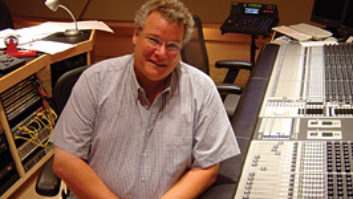While there will always be a market for, say, a bold new version of Wagner’s Ring Cycle or a fresh interpretation of Beethoven’s Middle Quartets, to sell a lot of classical albums these days usually requires either crossing over into more popular genres — purists be damned — or having some sort of gimmick such as a tie-in with a popular film. Or, how about this: five attractive piano-playing siblings, all of them Juilliard students or graduates, sometimes playing five pianos at once on well-worn classical “hits” such as Rimsky-Korsakov’s “Flight of the Bumblebee,” Paul Dukas’ “The Sorcerer’s Apprentice” and Edvard Grieg’s “In the Hall of the Mountain King.”
As I write this in mid-April, the 5 Browns’ eponymous debut album (actually, a dual-layer CD/DVD, the latter with a surround mix and video documentary) has been sitting atop the Billboard Classical chart for more than two months. There have been appearances on The Tonight Show, stories in magazines and even a 60 Minutes profile about this Mormon family of piano prodigies. And with a major U.S. tour currently underway, the 5 Browns look to be a fixture on the classical music landscape for a long time to come. However, a gimmick will only take a group so far; fortunately for the 5 Browns, they are a genuinely gifted bunch. The album offers a showcase for both their individual and collective talents — indeed, the strongest tracks may not be the pieces for five pianos, but rather, sisters Desirae and Deondra’s moody take on Ravel’s “La Valse” and brother Ryan’s alternately sensitive and powerful reading of Prokofiev’s “Sonata No. 3 in A Minor.”
Because this issue of Mix was set to feature a tutorial on piano recording (see page 26) we thought it would be interesting to investigate how the 5 Browns were captured in the studio. The CD was produced by Jay David Saks — an eight-time Grammy winner for various Broadway cast albums, and classical and opera recordings — and engineered by Tim Martyn, who recorded the family at Right Track Studios in Manhattan and mixed it in his Glen Rock, N.J., home studio using a Merging Technologies Pyramix workstation as his recorder and mixer. While the Browns may have been new to recording, their engineer was not: Martyn has engineered and/or produced hundreds of albums and is known as something of a piano specialist (not to mention a skilled pianist and Juilliard graduate himself). He has worked on and off with producer Saks for the past 15 years — often as a post engineer doing editing — and somehow also found the time to work as the audio engineer and live sound director for the Boston Symphony Orchestra’s Tanglewood Music Festival every summer for more than two decades. He is also the founder and former co-owner of New York’s Classic Sound recording studio.
Whether recording one piano or five, Martyn has a well-defined approach: “When I first got started 22 years ago or so, the engineers and producers I emulated all seemed to favor the two omnidirectional microphone approach. I follow much the same techniques today that I’ve used for over two decades. I did experiment with three spaced omnis for a while, but I am somewhat of a minimalist, I have to say.
“I started out in the early ’80s,” Martyn continues, “when the Schoeps MK2 omni was sort of the only flat response tool that we had in the early digital era, until B&K showed up with their 4006 omni. I haven’t used Schoeps microphones for a long time on piano; almost all of the recordings I’ve done up until somewhat recently have been with the B&K 4006s. And most of the Browns’ album was recorded with them.”
What does Martyn like about the B&Ks? “They’re very transparent and they have a very tight, clean low end,” he says. “A lot of the other omnis, like the Schoeps and the Sennheiser MKH-20s — as beautiful as they are — tend to swim a little in the bottom. For piano, it’s not that I like less bass exactly, but I like less bass than those other mics give you. And that’s one of the reasons the transparency is there with the B&Ks — they just clean out the bottom.”
However, Martyn notes, “On some of the piano recordings I’ve done recently that I’m quite happy with, I’ve started using a somewhat more unorthodox microphone choice: a pair of Neumann M149s, which I acquired a few years ago. The M149 has full selectable patterns and I’ve been experimenting using what I call the ‘almost omni’ setting, which is halfway between subcardioid and omni. It’s definitely a somewhat colored sound and it even requires a bit of EQ for my taste. But I’ve made some nice recordings with them.”
Back to the Browns: Martyn tracked the five-piano numbers first, and though it might seem like it would require a complicated setup, “It actually wasn’t too complex,” he says. “It was a 10-mic setup, all recorded at double sample rate [88.2 kHz]. We had a Decca Tree of 4006s over the five pianos [see photo, p. 126, and diagram above] and one Sennheiser MKH-40 that was a spot [mic] over each pianist’s right shoulder. Then there were two more mics on very tall black poles: two more 4006s fitted with nose cones, which were there for the rear surround and really not in the stereo mix at all. So we had 10 mics fed to a pair of Grace 801R mic preamps; they’re each eight channels. In the case of the five-piano pieces, I would say most of the pickup comes from the Tree, but the spots are definitely contributing.” Four of the pianos were American Steinways and one was a German Steinway.
Martyn describes the room at Right Track, A509, as “one of the last big rooms in New York that’s a real recording studio. In studio lingo, it’s ‘a live room,’ but it’s actually a fairly short reverb [time] as compared to what classical people are used to. We like to get up to two seconds or more, and this room does not get up to that. We have some other rooms that are better for classical music, but they’re not studios, so you have to bring all the equipment in. The American Academy of Arts and Letters is the hall we use most often to record solo piano, but Right Track worked out really well for this project.”
To record a single piano, as he did on half of the album’s tracks, “I put the lid back on the piano and then tried to get the mics — a pair of 4006s — at kind of a 45-degree angle, aimed at the hammers. They’re not at the tail of the piano looking at the pianist’s face, and not out front of the piano looking at the lid; they’re halfway in between those two perspectives.” Martyn varies the distance of the pair from the piano depending on a number of different factors, including the sound of the individual piano and the hall or studio in which it’s being recorded, but typically double an arm’s length or a little more.
Martyn says that the pieces required minimal editing, and mixing in Pyramix was relatively easy; it’s been his preferred medium for some time. However, the surround mix was a little more complex and for that task, Saks and Martyn went to New York’s Sync Sound and worked alongside noted mixer Ken Hahn. “People say, ‘Great, five speakers, five pianos.’ But we didn’t approach it that way,” Martyn says. “That would’ve been like the early quad days: four speakers, a string quartet, put one in each. But with the Browns on the pieces with five pianos, we were after a more traditional surround sound environment: very good stereo up front and a little real hall ambience [in back] to give it some realism.
“I came up with a static mix for each piece using the Tree and a certain level for the spot mics. Then Jay listened and there were a handful of places where he thought piano three or piano one or whatever needed to be enhanced for a bar-and-a-half, so we made some little fader moves, but mostly the musicians balanced themselves.”
Since recording the 5 Browns, Martyn has worked on a number of other classical piano recordings, such as Dubravka Tomsic for IPO Records, Cuban master Juana Zayas (who is re-recording the Chopin Etudes she famously cut in the early ’80s) and the talented Czech Ivan Moravec. But he’s also clearly enjoying the unparalleled success of The 5 Browns. “I’m pretty sure it’s my first Billboard Number One piano album,” he says with a chuckle. “Those kids deserve it, too. The whole family — the mother, father, all the kids — is amazing. They’re smart, they’re nice, they work hard. They are genuinely great kids, so it’s nice to see them do well.”




